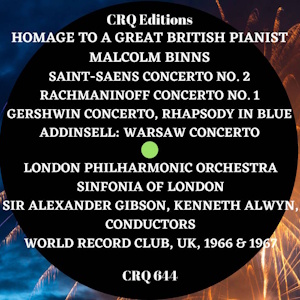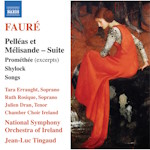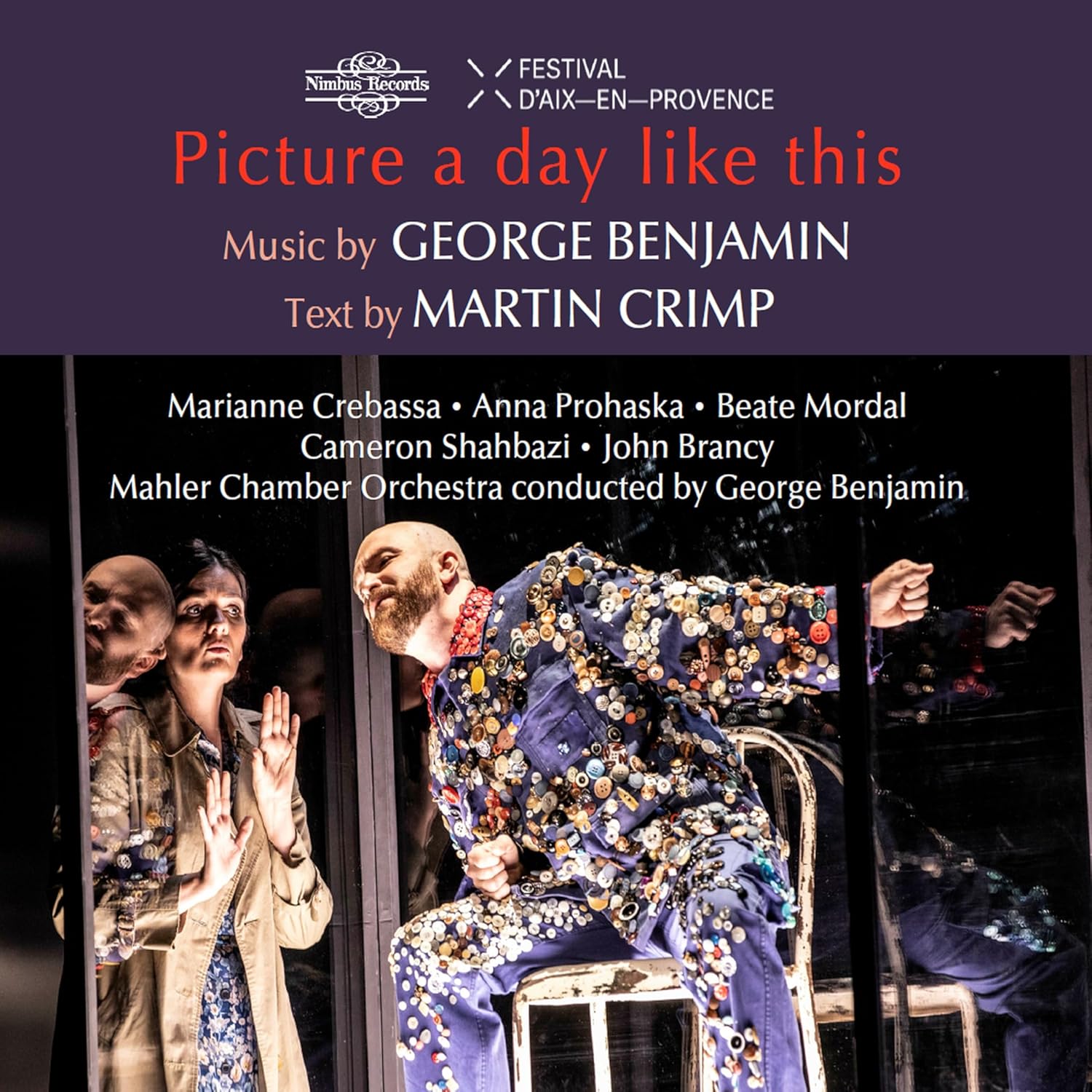
Malcolm Binns (piano)
Homage to a great British pianist
London Philharmonic Orchestra/Alexander Gibson (Saint-Saëns, Rachmaninov)
Sinfonia of London/Kenneth Alwyn (Gershwin, Addinsell)
rec. 1966 (Gershwin, Addinsell), 1967 (Saint-Saëns, Rachmaninov), Abbey Road Studios, London
Reviewed from WAV files
CRQ Editions CRQ644 [107]
Malcolm Binns (b. 1936) came from the same generation as fellow British pianists Peter Frankl, David Wilde and John Ogdon. Peter Katin was a little older. In most cases, their rich legacy on record has now been re-issued, but these discs Malcolm Binns made for the World Record Club are here receiving their first digital release.
The World Record Club was established in the mid-1950s. By the early 60s, EMI had acquired a controlling interest and by 1966, when the first of these records was made, the club had over 200,000 members. By this time however, the majors had cottoned on and were offering their own budget releases (like Decca’s Ace of Clubs label). After 1970, the operation was in its twilight years.
Malcolm Binns is a fine artist and difficult to pigeon-hole. He appeared at the Proms throughout the 1960s (almost every season) and even did three last nights, each time playing one of the Rawsthorne concertos. He is perhaps best remembered for his series of excellent records for L’Oiseau-Lyre in the late 1970s where he played on all manner of harpsichords and fortepianos and even recorded a Beethoven sonata set in this style. Later on, Lyrita recorded him in several discs of British music and he can also be found on the Pearl label, on Chandos and even Hyperion.
World Record Club released ST672 (the ST prefix meant Stereo Twelve-inch) in 1968. It is a super LP, recorded the previous year at Abbey Road. Alexander Gibson (pre-knighthood) conducted the LPO. Saint-Saëns’ Piano Concerto No. 2 had been written in a 17-day period exactly 100 years earlier in 1868. It is a virtuosic work and no mistake. Binns’ rapid figurations and nimble finger-work is in evidence throughout. The splendid stereo sound is captured well from the very opening Bachian Fantasia. The balance between piano and orchestra is engineered masterfully. The broad first movement with its two themes, is nicely paced and phrased by the artists; lovely cascading from Binns leads to wild and stormy fortissimo chords at around the 6:00 marker. I checked the old Moiseiwitsch 78s and the absolute go-to recording of this work, Gilels on Columbia, and no-one plays with this abandonment. It is all very impressive and he does a splendid cadenza, too (huge in this work).
The playful scherzo middle movement is dashed off with great style and plenty of glitter and sparkle. In the fiery finale, like the first movement set in G minor, Binns and Gibson adopt a good tempo for the saltarello. The constant trills that start at 2:03 move through a world of harmony before erupting into a torrent that brings back the first theme in a display of greatness from the composer. I do love the work and was pleased to reacquaint myself with it in this very intense and infectious reading. Audiophiles will love the sound levels and stereo separation but there is some background noise at times on the tape. It is not pre-echo, but it is there, nonetheless. It is a tiny detail, that’s all. 23 minutes is the timing of the concerto.
On the other side of the record was Rachmaninov’s Piano Concerto No. 1, one of my favourite Opus 1’s. Rachmaninov wrote most of this work at the age of seventeen, but revised it in later years. Was it the impetuosity of youth that led to Rachmaninov being so bold in his opening to this work? Crashing octaves blaze down in a mad flourish before things settle with the gorgeous strings laying out their calming song. The soaring lyric theme is taken on by Malcolm Binns for a while before he’s off again in a crazed scherzo-like episode. The to-ing and fro-ing in this piece is fascinating and puts me in awe of the Russian master’s sheer genius and talent at this early stage of his career. There is some beautiful playing, not least from the LPO and Binns’ cadenza to the first movement is heart-felt and appropriately pesante.
The slow movement is just lovely. Perfectly measured and a real sense of ensemble. The finale shimmers in a virtuosic outpouring of energy. The tender interlude in the middle offers us a little respite from the avalanche of chords thrown off with aplomb by the Binns/Gibson partnership. It is a performance (28 minutes in duration) well worth hearing, if not eclipsing a special one made for another subscription club, Reader’s Digest, a couple of years earlier. That set of Rachmaninov concertos from Earl Wild and the RPO under Horenstein is essential and has rarely been out of circulation since.
The WRC record was produced by the great partnership of Anthony C. Griffith and Christopher Parker. The Rachmaninov was definitely reissued on Classics for Pleasure in the late-70s, but I can’t find any other release of the Saint-Saëns.
Next on this new disc from CRQ Editions is the Gershwin Piano Concerto made a year earlier than the previous record in 1966. I adore this work. That season, Gershwin’s Lady, Be Good played on Broadway (330 times) and he followed his previous year’s success in Rhapsody in Blue with the original work we hear now in this performance from Binns, the Sinfonia of London and conductor Kenneth Alwyn.
Gershwin is true to his principals and his true self in the work. He didn’t try to Europeanise his compositional style and the work is steeped in jazz and Broadway. In its cyclic structure, where themes keep returning from previous places in the work, you might argue he was influenced by French music not least Franck, but the piece is totally original and reeks of Americana through and through. Unlike in Rhapsody in Blue, the orchestration is 100% authentically Gershwin.
The Roaring Twenties is the theme. Malcolm Binns gets the idiom completely. He sets out the second theme in solo (1:29) very nicely after the orchestra have thrown around the first for a while. The first movement is successful in all its twists and turns and the sound is again good (for these sessions, a different technical team sit behind the desks). Gershwin’s melodic invention is amazing; how he can take a theme so small and insignificant and make of it what he does is a real marvel. The second movement, with its sultry nighttime atmosphere, is magical. The bluesy trumpet is perfect and the clarinets add real character. Binns makes a lovely cadenza in this movement. In the final rondo there is no let-up in the pace at all. As well as the precision pianism of Binns being spotlit, several sections of the orchestra get to show off too, including the percussion. It is very showy and up-front, something Gershwin was starting to realise he was pretty good at. The performance of the Gershwin concerto comes in at 32 minutes.
One of my favourite versions of the Gershwin is older than this one. In 1955 Decca made it with Julius Katchen, Mantovani and his orchestra. It is in mono only and snobbish collectors probably wouldn’t approve; they are missing out, though. It is Gershwin gold and I am pretty sure George himself would have adored it.
With the demise of the World Record Club, EMI’s CfP label re-issued the Gershwin coupled with the same partnership’s Rhapsody in Blue. The Sinfonia of London sound like they are enjoying these sessions (I love those trumpet wah-wahs). As with the concerto, Binns is charming and can definitely sing the blues. The final music on this release is the Warsaw Concerto by Addinsell. Written for the film Dangerous Moonlight in 1941 and performed on the soundtrack by Louis Kentner, the original record was released due to unprecedented public demand on a cheap Columbia (DX1062). You can still find plenty around; it sold in the thousands, but getting a clean copy is harder. I looked around for years before I found a perfect, almost un-played one. The work is part of gramophone history and a pretty well-crafted piece actually. This account by Malcom Binns is thoroughly thought through – a nice way to end the record.
I have enjoyed listening to these early records of Malcolm Binns and commend the work of CRQ Editions who have blown away the cobwebs from the covers, the dust from the grooves and restored them to us as pristine.
Philip Harrison
Availability: CRQ EditionsContents
Camille Saint-Saëns (1835-1921)
Piano Concerto No. 2 in G minor, Op. 22
Sergei Rachmaninov (1873-1943)
Piano Concerto No. 1 in F sharp minor, Op. 1
George Gershwin (1898-1937)
Piano Concerto in F
Rhapsody in Blue
Richard Addinsell (1904-1977)
Warsaw Concerto


















